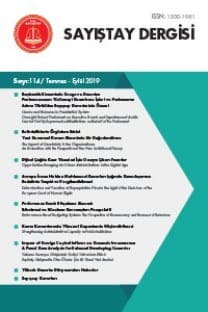Avrupa Birliği Ülkelerinde Savunma Harcamalarını Belirleyen Ekonomik ve Sosyal Faktörler: Panel Veri Analizi
Bu çalışmanın amacı, ekonomik ve sosyal faktörlerin ülkelerin savunma harcamaları üzerindeki etkisinin araştırılmasıdır. Bu amaçla, 1980-2014 yıllarını kapsayan bir dönem için, ekonomik ve sosyal faktörlerin savunma harcamaları üzerindeki etkileri AB üyesi 28 ülke örnekleminde “Panel Veri Analizi” kullanılarak ekonometrik açıdan incelenmiştir. İlgili literatürde savunma harcamaları belirleyicilerinin tespitinde genellikle kullanılmakta olan Neoklasik model üzerinden çalışma açıklanmaya çalışılmıştır. Bu çalışmada Neoklasik Model temelinde, bağımlı değişken olarak savunma harcamaları kullanılmıştır.Analiz sonucunda; sosyal göstergelerden insan hakları ve politik hakların bağımlı değişken üzerinde etkisinin negatif; ekonomik faktörler arasında yer alan dışa açıklık derecesi ve vergi gelirlerinin milli gelir içindeki payının ise pozitif etkiye sahip olduğu gözlenmiştir. Kişi başına milli gelir ile bağımlı değişken arasında istatistiksel olarak negatif bir ilişki olduğu çalışmadan çıkarılacak diğer sonuçlar arasında yer almaktadır
Anahtar Kelimeler:
Savunma Harcamaları, Kurumsal Faktörler, İnsan Hakları, Politik Haklar
ECONOMICAL AND SOCIAL FACTORS THAT DETERMINE THE MILITARY EXPENDITURE OF EUROPEAN COUNTRIES: A PANEL DATA ANALYSİS
This study aims to examine the impact of economical and social factors on the military expenditures. For this purpose, in the sample consisting of 28 EU member states, the impacts of economical and social factors on the military expenditures for the period of 1980-2014 have been analyzed econometrically using “Panel Data Analysis”. An attempt was made to explain the study via the Neoclassical Model which is the model generally used for finding the military expenditure determiners in the relevant literature. In the present study, military expenditures were used as the dependent variable in the base of Neoclassical Model. The analysis shows that human rights and political rights, two of social indicators, have negative effects on the dependent variable whereas openness and the share of tax revenues in the national income, which are included in the economical factors, have positive effects. The fact that there is a statistically negative correlation between per capita income and the dependent variable is another finding to be concluded from the study
Keywords:
Military Expenditures, Institutional Factors, Human Rights, Politic Rights,
___
- ACDA (2013), U.S. Arms Control and Disarmament Agency: http://dosfan.lib.uic. edu/acda/, Erişim Tarihi: 13.04.2013.
- SIPRI (2015), Stockholm International Peace Rerearch Institute: http://www.sipri. org/research/armaments/milex/milex_database/definitions, Erişim Tarihi: 12.05.2015.
- Baltagi, B. H. (2005), Econometric Analysis of Panel Data. Wiltshire: John Wiley & Sons.
- Berlin, D. P. (1992), Military Autonomy and Emerging Democracies in South America, Comparative Politics, s. 83-102.
- Brzoska, M. (1995), World Military Expanditures. K. Hartley, & T. Sandler içinde, Handbook of Defense Economics (s. 46-65), York, England: Elsevier Science.
- Cameron, C., & Trivedi, P. K. (2005), Microeconometrics: Methods and Applications. Cambridge: Cambridge University Press.
- Collier, P., & Hoeffler, A. (2002), Military Expenditure: Threats, Aid and Arms Races. World Bank Policy Research Working Paper, November, 2927(2927).
- Collier, P., & Hoeffler, A. (2007), Unintended Consequences: Does Aid Promote Arms Races? Oxford Bulletin of Economics and Statistics.
- Davoodi, H., Clements, B., Schiff, J., & Debaere, P. (2001), Military Spending, the Peace Dividend, and Fiscal Adjustment, IMF Staff Papers, 48(2): 290-316.
- Dommen, E., & Maizels, A. (1988), The Military Burden in Developing Countries, The Journal of Modern African Studies, 377-401.
- Doucha, M., & Solomon, B. (2013), Middle Powers and the Demand for Military Expenditures, Defence and Peace Economics, 25(6): 605-618.
- Dunne, P., & Freeman, S. P. (2003a), The Demand for Military Spending in Developing Countries, International Review of Applied Economics, 23-48.
- Dunne, P., & Freeman, S. P. (2003b), The Demand for Military Spending in Devoloping Countries: A Dynamic Panel Analysis, Defence and Peace Economics, 461-471.
- Dunne, P., & Freeman, S. P. (2010b), The Demand for Military Spending in Developing Countries: A Dynamic Panel Analysis, Defence and Peace Economics, 461-473.
- Dunne, P., & Mohammed, N. (1995), Military Spending in Sub-Saharan Africa: Some Evidence for 1967-85, Journal of Peace Research, 331-343.
- Dunne, P., Freeman, S. P., & Smith, R. (2008), The Demand for Military Expanditure in Developing Countries: Hostility Versus Capability, Defence and Peace Economics, 293-302.
- Fonfría, A., & Marín, R. (2012), Determinants of the Demand for Defence Expenditure in the NATO Countires, Journal of the Higher School of National Defense Studies, 9-30. Freedom House (2014)
- http://www.freedomhouse.org/report/freedom
- world-2011/checklist-questions#.U0U6xkBrO8B Erişim Tarihi: 15.04.2014.
- Hartley, K., & Sandler, T. (1995), Handbook of Defence Economics, Holland.
- Hewitt, D. (1996), Military Expenditures 1972-1990: The Resons behind the Post-1985 Fall in World Military Spending. Public Budgeting and Financial Management, 520-558.
- Hsiao, C. (2003), Analysis of Panel Data, New York: Cambridge University Press.
- Isard, W., & Anderson, C. (1988), A Survey of Arm Race Models. Cambridge: Cambridge University Press.
- Lucier, C. E. (1979), Changes in the Values of Arms Race Parameters. The Journal of Conflict Resolution.
- Nikolaidou, E. (2008), The Demand for Military Expenditure: Evidence from the EU15 (1961–2005). Defence and Peace Economics, 19(4): 273-292.
- Polachek, S. W., & Seiglie, C. (2007), Trade, Peace and Democracy: An Analysis of Dyadic Dispute, in T. Sandler, & K. Hartley (Eds.), Handbook of Defense Economics, Volume 2: 1018-1039, Elsevier.
- Richardson, L. (1960), Arms and Insecurity: A Mathematical Study of Causes and Origins of War, Pttsburg: Boxwood Press.
- Smith, R. (1980), Military Expenditure and Inverstment in OECD 1954-1973 (Cilt 1), Journal of Comparative Economics.
- Smith, R. (1980). The Demand for Military Expenditure, Wiley on Behalf of the Royal Economic Society.
- Tambudzai, Z. (2007), Military Burden Determinants in Southern Africa, 1996-2005: A Cross-section and Panel Data Analysis. Economic Development in Africa Conference (s. 1-25), Oxford: St Catherine’s College.
- Tatoğlu, F. Y. (2013), İleri Panel Analizi, İstanbul: Beta Yayınları.
- Wang, Y. (2012), Determinants of Southeast Asian Military Spending in the Post-Cold War Era: A Dynamic Panel Analysis, Defence and Peace Economics, 24(1): 73- 87.
- Wooldridge, J. M. (2001), Econometric Analysis of Cross Section and Panel Data. Cambridge: The MIT Press.
- ISSN: 1300-1981
- Yayın Aralığı: 4
- Başlangıç: 1990
- Yayıncı: T.C. Sayıştay Başkanlığı
